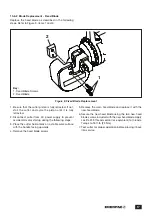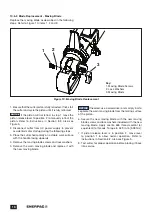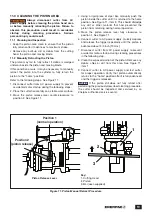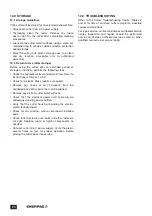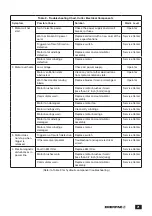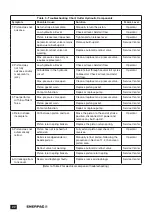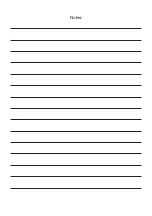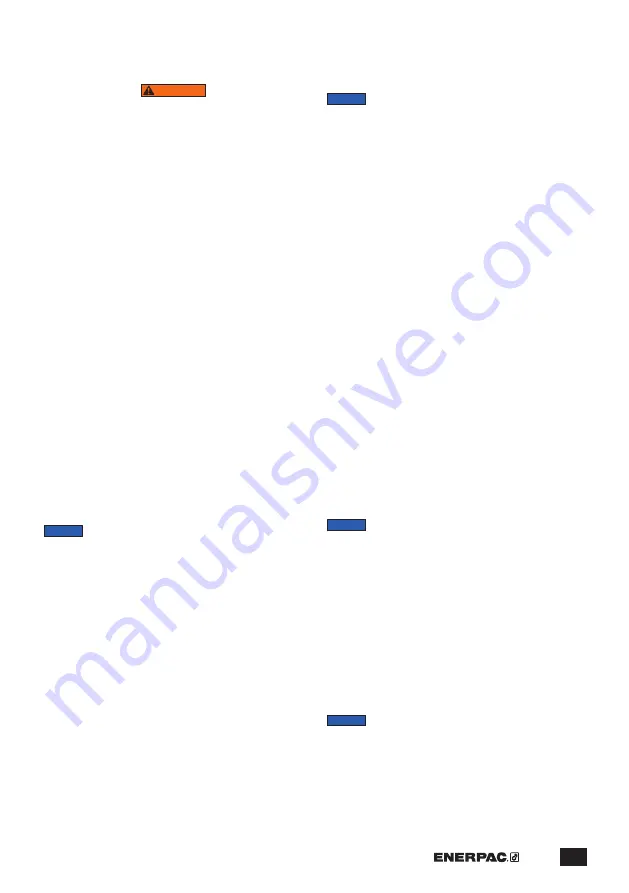
13
4. To prevent contamination, remove any built-up dust
and dirt from the oil reservoir cap and surrounding area.
NOTICE
A small amount of hydraulic oil may leak from
the drain/fill hole when cap is loosened in the next step.
Be prepared to catch this oil in a pan or with a clean rag.
Dispose of spilled oil in accordance with all applicable
laws and regulations.
5. Slowly loosen the oil reservoir cap while watching for
oil flow:
• If oil starts flowing from the oil drain/fill hole as the
cap is loosened, the reservoir is full. Tighten the
cap immediately. To avoid excessive oil spillage,
do not continue loosening the cap if oil flow
occurs. Skip steps 6 through 8 and go on to step 9.
• If no oil flow occurs when the cap is loosened,
fully loosen and remove the cap. Then, check
oil level and add oil (if needed) as described in
steps 6 through 8.
6. Check the oil level in the drain/fill hole. Oil level will be
up to the top of the hole when reservoir is full.
7. If oil level is low, slowly add new Enerpac HF oil
through the oil drain/fill hole, until the oil level is up to
the top of the hole.
8. Remove any residue or metal particles from the oil
reservoir cap (it is magnetic).
9. Install and securely tighten the oil reservoir cap.
10. Using a clean rag, wipe the cutter housing, grip and
motor so that these surfaces are free of oil residue.
11. Connect cutter to AC power supply. Cycle the
piston several times to test for proper operation
before placing the cutter back into service.
10.5.3 Changing the Oil
NOTICE
The oil change procedure is very detailed and
will take a considerable amount of time. It should only
be performed by a trained technician at an Enerpac
authorized service center. Failure to properly perform
the procedure may result in incomplete filling of the
cutter oil reservoir, which could lead to cavitation, air
entrainment, reduced performance, and pump damage.
Change the oil in the cutter reservoir as described in the
following steps. Refer to Figures 8A through 8E:
1. Fill a clean oil dispenser with new Enerpac HF oil. Put
the dispenser aside for later use.
2. Procure a thick, soft metal bar (about 1/4 inch
[6.4 mm] minimum thickness). Put the bar aside for
later use.
NOTICE
The bar selected should be easy to cut, but not
brittle. The bar material must be soft enough so that the
bar will not break into two pieces before it is fully cut.
Later in this procedure, the bar will be partially cut so
that it becomes lodged in between the jaws of the cutter
without being cut through completely, as the piston is
extended to slightly less than maximum travel.
10.5.1 Hydraulic System Maintenance Precautions
NOTICE:
WARNING
Always disconnect cutter from AC power supply
before performing hydraulic system maintenance.
Failure to observe this precaution could result in
accidental startup while maintenance procedures
are being performed. Serious personal injury and
damage to cutter may result.
Wait for cutter to cool before performing hydraulic
system maintenance. Hot oil can cause burns.
Be sure that oil reservoir cap is securely tightened
after checking oil level or changing the oil. Leaking
oil can cause short circuits, fire and explosions.
Additional Precautions:
• Do not check oil level or change the oil in dusty areas.
• Be sure that all tools (wrench, screwdriver, etc.) used
to perform maintenance procedures are clean.
• When adding oil and performing oil changes, take every
precaution to prevent impurities from contaminating
the oil or entering the cutter. Impurities can cause
permanent damage to the hydraulic components.
• The hydraulic reservoir contains a rubber diaphragm
that slightly pressurizes the oil. Some oil spillage may
occur when checking the oil level or when changing
the oil. Wear and/or use appropriate personal
protective equipment (PPE) to prevent exposure to
hydraulic oil.
• Use only new Enerpac HF hydraulic oil poured from a
clean container. Use of other oil brands and/or used
oil may damage the cutter and may void the Enerpac
product warranty.
10.5.2 Checking Oil Level and Adding Oil
NOTICE
The reservoir contains a flexible rubber
diaphragm that slightly pressurizes the oil. To help prevent
excessive oil leakage when the reservoir cap is removed,
be certain that the piston is advanced until there is a gap
of about 1/8 inch [3-4 mm] between the fixed and moving
blades (as described in step 1) before loosening the cap.
The gap between the blades should not be less than
1/8 inch [3-4 mm]. A smaller gap may result in the
piston retracting unexpectedly while the oil level is being
checked.
Refer to Figures 8A through 8E during the following steps:
1. Operate the cutter and advance the piston until
there is a 1/8-inch [3-4 mm] gap between the fixed
and moving blades (until just before the piston
automatically returns).
2. Disconnect the cutter from the AC power supply to
prevent accidental motor startup during the following
steps.
3. Place the cutter in the horizontal position, on a stable
and level work surface, with the oil reservoir cap
facing upwards. Place a pan or suitable container
under the cutter to catch any spilled oil.
Summary of Contents for EFBE5017
Page 23: ...Notes...
Page 24: ...WWW ENERPAC COM...

















